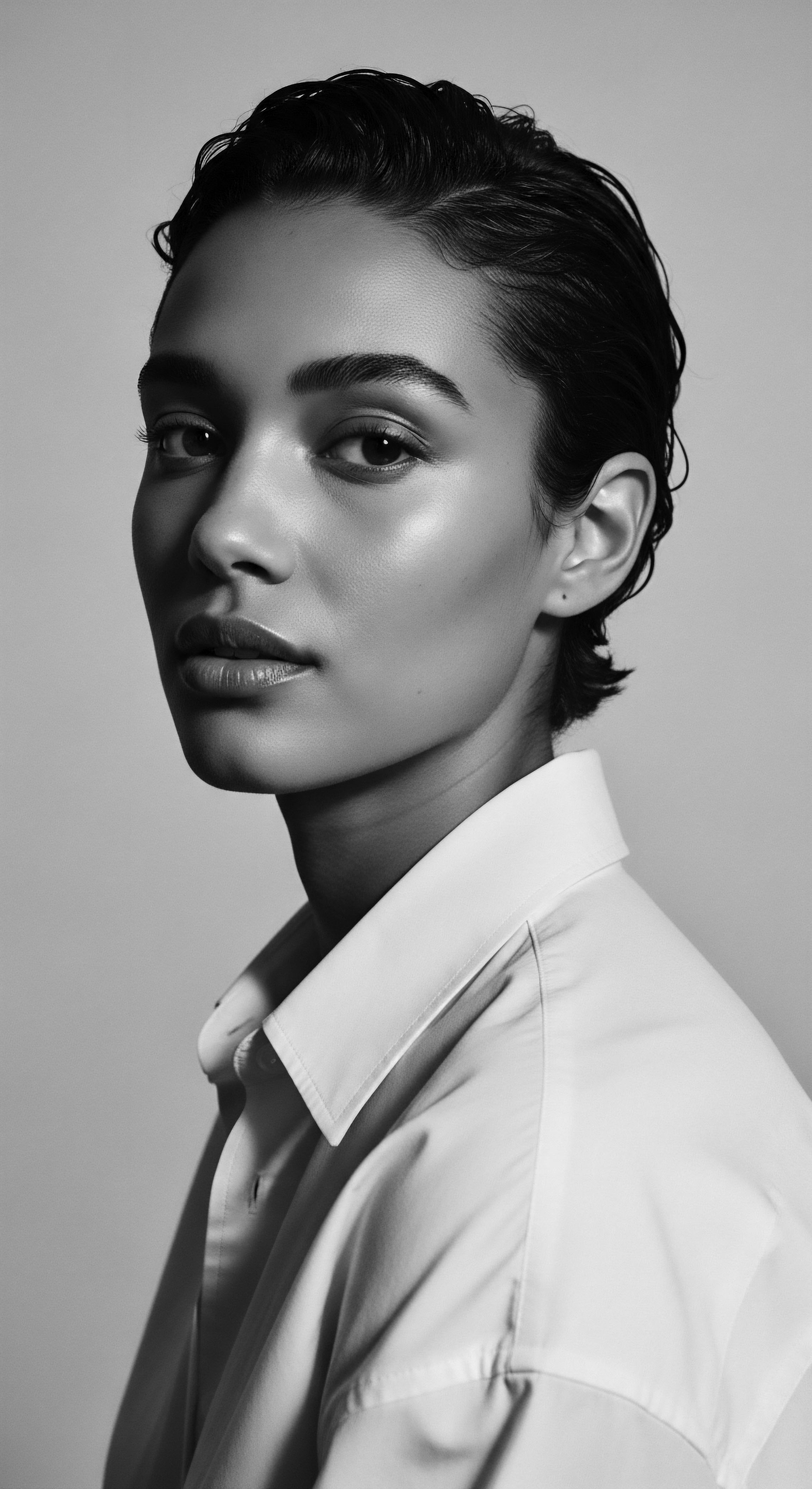
Fundamentals
The understanding of Cultural Identity, particularly when viewed through the lens of textured hair, is not merely an academic exercise; it is a profound journey into the very spirit of a people. For Roothea, this exploration commences at the elemental source, acknowledging hair as far more than mere biological filament. It is a living archive, a repository of ancestral memory, and a visible declaration of belonging.
Our definition of Cultural Identity, therefore, begins with the recognition of its intrinsic connection to the coils, kinks, and waves that crown the heads of Black and mixed-race individuals, tracing its lineage back to the dawn of human adornment. This identity is not static; it is a dynamic expression, a language spoken through strands, imbued with the echoes of ancient practices and communal wisdom.
In its simplest expression, Cultural Identity, within the context of textured hair, signifies the collective sense of self, shared history, and communal belonging that finds articulation through hair practices, aesthetics, and the very structure of one’s hair. This is a meaning deeply rooted in ancestral understandings, where hair was never divorced from the person, the family, or the wider community. Early societies recognized hair as a potent symbol, a connection to the divine, and a marker of one’s place in the world.
Cultural Identity, through the lens of textured hair, is a living declaration of shared history and communal belonging, whispered through every coil and strand.
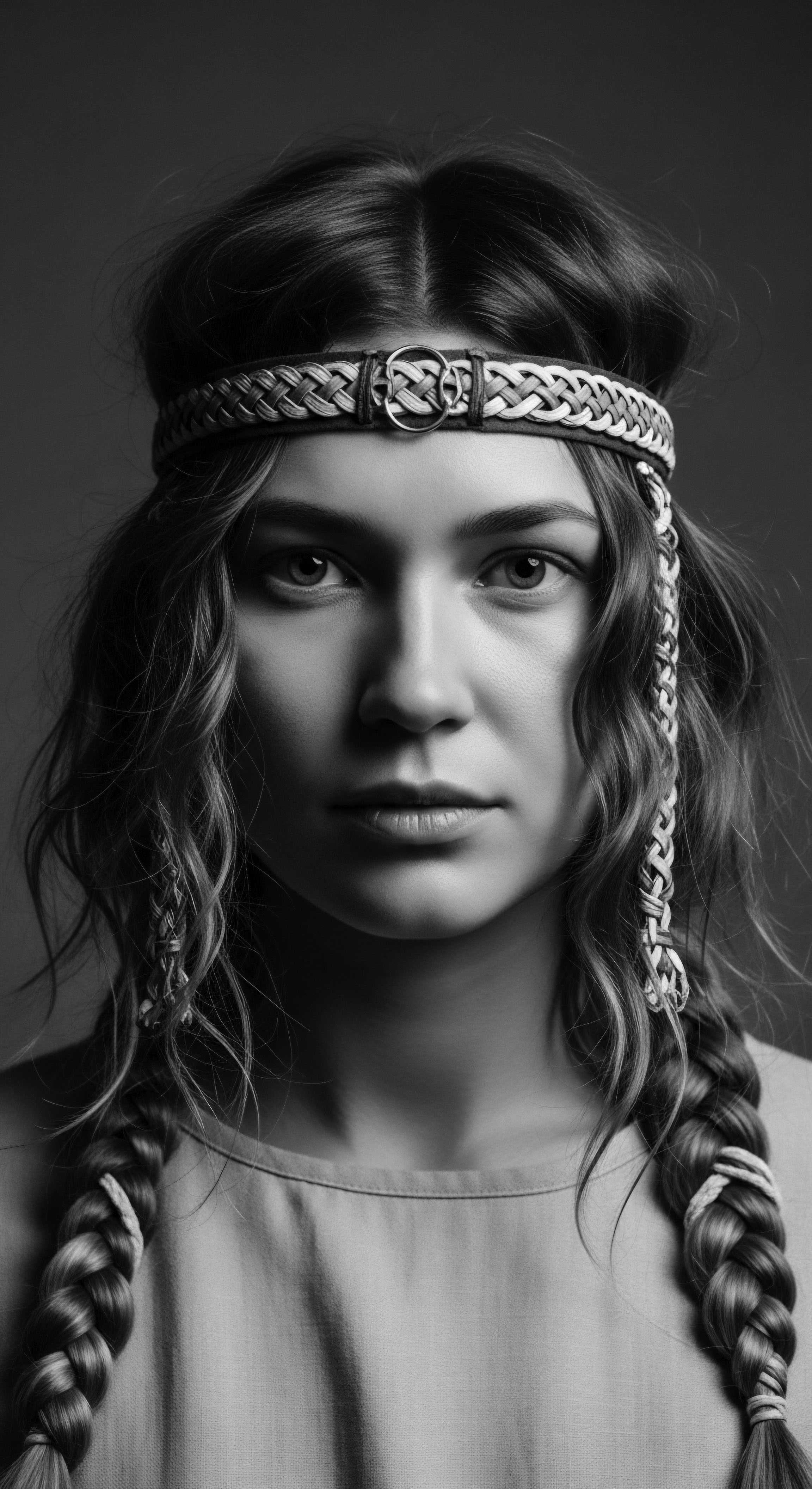
Echoes from the Source ❉ Hair as Ancestral Adornment
Long before written records, human societies across the African continent understood hair as a powerful element of individual and collective being. Its growth from the scalp, the highest point of the body, often linked it to spirituality and the celestial realm. This perspective established hair not just as an aesthetic feature, but as a conduit for spiritual connection and a vessel for ancestral knowledge. Early depictions of women with cornrows, for instance, date back to Stone Age paintings in the Tassili Plateau of the Sahara, as early as 3000 BCE, demonstrating the enduring presence of these styles.
The care and styling of hair were communal rituals, often performed by elders or skilled practitioners, reinforcing social bonds and transmitting cultural wisdom across generations. These were moments of teaching, sharing, and strengthening community ties, where the rhythmic motions of braiding or twisting became a form of storytelling. The unique texture of Black hair, with its remarkable ability to hold intricate patterns, naturally lent itself to elaborate designs, transforming the head into a canvas for identity.
- Hair as Status Marker ❉ In many pre-colonial African societies, hair patterns communicated social rank, age, marital status, wealth, or tribal affiliation.
- Hair as Spiritual Connection ❉ The elevated position of hair on the body often symbolized a link to the divine or ancestral spirits.
- Hair as Community Ritual ❉ Hair care practices, such as braiding, were communal activities, fostering social cohesion and intergenerational learning.

The First Strands of Belonging ❉ Pre-Colonial Meanings
Across diverse African ethnic groups, hair held profound communicative significance. A person’s hairstyle could instantly convey a wealth of information about their personal history and social standing. For instance, the Wolof, Mende, Mandingo, and Yoruba peoples utilized specific hairstyles to transmit messages during the 15th century. These were not simply decorative choices; they were deliberate statements, understood by all within the community.
In certain West African cultures, the very density and appearance of hair were associated with abundance and vitality. Proverbs from the Yoruba and Mende ethnic groups, for example, described hair as a “Black crown” and linked it to “abundance” and “plenty.” This perception starkly contrasts with later colonial narratives that sought to diminish the intrinsic beauty and value of textured hair. The artistry involved in creating these elaborate styles, which could take hours or even days to complete, underscored their cultural value and the skill of the stylists.
The combs used for hair care also possessed deep cultural meaning, often carved with symbols that indicated a person’s group, spiritual affiliations, or personal history. These tools were specifically designed with long teeth and rounded tips to detangle and manage textured hair, reflecting an ancient understanding of its unique needs. The care and styling of hair, then, were integral to the daily life and collective consciousness of these communities, a testament to the enduring significance of hair as a primary component of cultural identity.
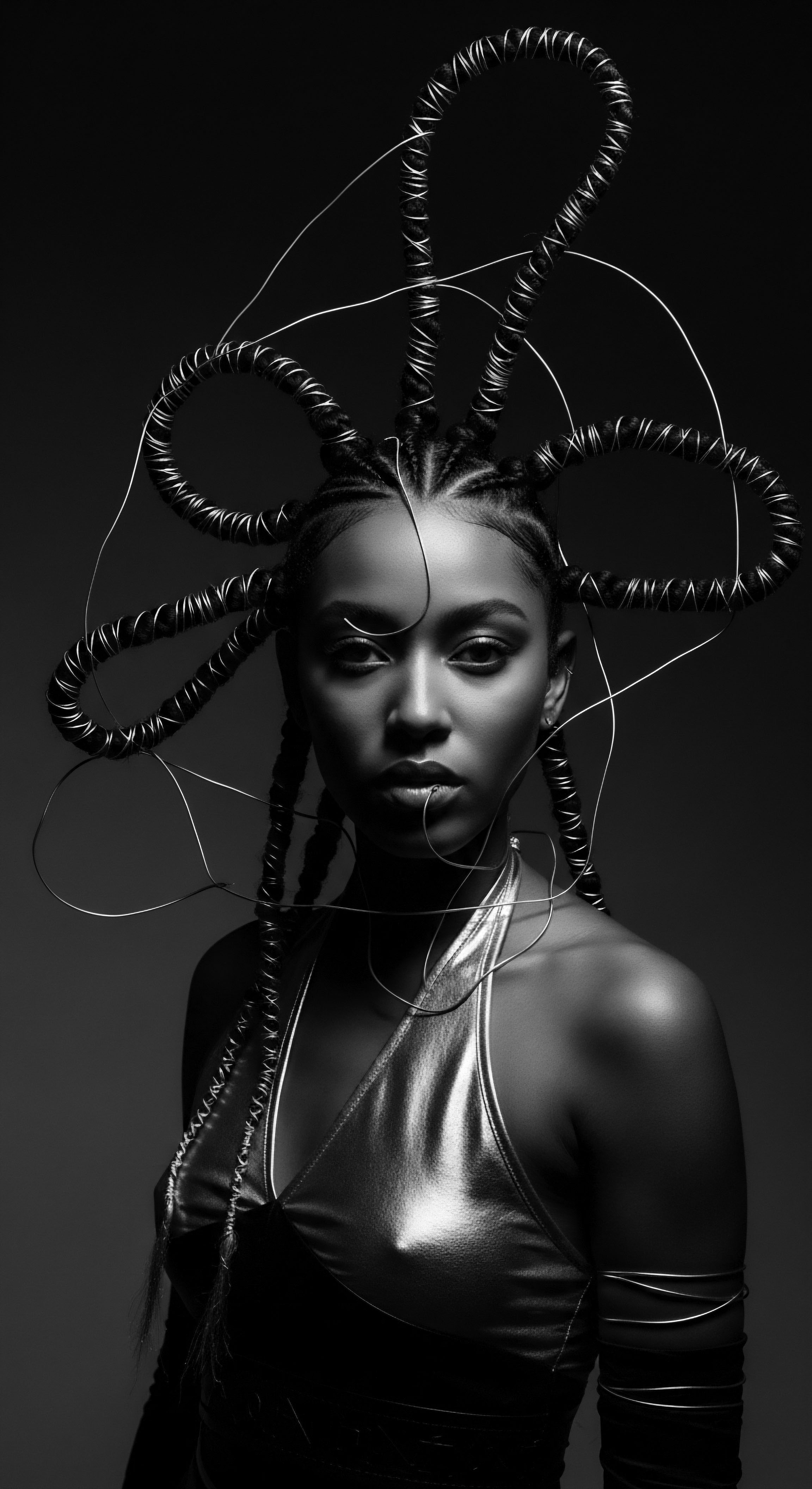
Intermediate
Moving beyond the foundational elements, an intermediate understanding of Cultural Identity within textured hair explores how these ancient meanings have been transmitted, adapted, and fiercely guarded across generations, particularly in the face of immense historical pressures. The concept expands to encompass the dynamic interplay between inherited traditions and the evolving expressions of self and community, especially within the vast and diverse Black and mixed-race diaspora. Here, Cultural Identity is a living, breathing testament to resilience, a continuous dialogue between past wisdom and present circumstance. It represents the collective memory of care, community, and quiet defiance, woven into the very fabric of daily life.
This deeper look reveals how hair care practices, initially rooted in ancestral knowledge, transformed into vital rituals of survival and cultural preservation. These are not static historical facts, but rather ongoing practices that hold profound contemporary relevance, shaping individual and collective identity in nuanced ways. The methods and materials employed reflect a deep connection to the earth and an intuitive grasp of what textured hair requires to thrive, passed down through the hands and voices of countless caregivers.

The Tender Thread ❉ Living Traditions of Care and Community
The generational continuity of hair care practices forms a tender thread connecting diasporic communities to their African origins. Hair washing, oiling, detangling, and styling were, and remain, intimate acts of care that often take place within family circles. These rituals are not merely about hygiene or aesthetics; they are moments of bonding, storytelling, and instruction.
Children learn the specific methods for managing their coils and curls from mothers, grandmothers, aunts, and older siblings, absorbing not just techniques, but also the cultural stories and values associated with their hair. This intergenerational transmission of knowledge is a powerful mechanism for preserving cultural identity.
Traditional ingredients, sourced from the natural world, played a central role in these care routines. Shea butter, various plant oils, and herbal infusions were utilized for their moisturizing, strengthening, and healing properties. These practices were often empirical, developed over centuries of observation and communal sharing, long before modern science could explain their biochemical efficacy. The use of these natural components speaks to a deep ancestral wisdom regarding holistic well-being, where the body, including the hair, is viewed as interconnected with the natural environment.
The enduring wisdom of ancestral approaches to textured hair care, often centered on natural ingredients and communal rituals, finds intriguing echoes and expansions in our contemporary scientific comprehension.

Diasporic Expressions ❉ Adaptation and Resilience
The transatlantic displacement presented an unprecedented challenge to the maintenance of African hair traditions. Enslaved individuals were often subjected to forced head shavings upon arrival, a deliberate act of dehumanization designed to strip away their cultural identity and sever ties to their homeland. Despite these brutal attempts at erasure, the spirit of cultural identity, expressed through hair, persisted. Hair became a clandestine canvas for resistance and a covert communication system.
One particularly poignant historical example is the use of Cornrows as Maps and Conduits for Survival during Enslavement. In various parts of the Americas, particularly documented in Colombia by figures like Benkos Biohó, enslaved African women intricately braided patterns into their hair that secretly conveyed escape routes. These complex designs could indicate paths to freedom, signal meeting times, or even map out terrain.
Beyond navigational guides, these tightly woven braids also served as hidden compartments, concealing gold fragments or precious seeds, allowing individuals to carry a piece of their past and a promise of future sustenance during their perilous journeys to liberty. This practice demonstrates the profound ingenuity and unwavering resolve of those who refused to surrender their cultural identity, transforming an act of personal grooming into a powerful statement of defiance and hope.
This historical example highlights how hair, despite being targeted for suppression, became a powerful instrument for cultural preservation and resistance. The act of maintaining traditional styles, even in simplified forms due to harsh conditions, represented a profound refusal to abandon one’s ancestral self. These practices became symbols of unity and shared struggle, allowing individuals to maintain a connection to their heritage even when separated from their communities.

The Alchemy of Ingredients ❉ Ancestral Wisdom in Practice
The knowledge of natural remedies and botanical components for hair health was an invaluable part of ancestral heritage. This traditional wisdom, often passed down orally, recognized the therapeutic properties of various plants and minerals. While modern science now quantifies the benefits of these elements, their efficacy was understood through generations of observation and application.
Consider the use of plants like Henna (Lawsonia inermis L.) for strengthening and coloring hair, or Rosemary (Rosmarinus officinalis L.) for addressing hair loss. These practices were not random; they were part of a sophisticated system of traditional care. Ethnobotanical surveys, even today, continue to document the rich array of plants traditionally used for hair and scalp wellness in various African regions. This collective body of knowledge forms a practical aspect of Cultural Identity, providing tangible links to ancestral ways of maintaining hair vitality.
| Traditional Ingredient Shea Butter (Vitellaria paradoxa) |
| Ancestral Application Moisturizer, protective barrier, scalp conditioner. |
| Modern/Scientific Link to Hair Wellness Rich in fatty acids (oleic, stearic), vitamins A and E; provides deep hydration, reduces breakage, anti-inflammatory for scalp. |
| Traditional Ingredient African Black Soap (Ose Dudu) |
| Ancestral Application Gentle cleanser for hair and scalp, addresses scalp conditions. |
| Modern/Scientific Link to Hair Wellness Contains plantain skins, cocoa pods, shea tree bark; provides gentle cleansing without stripping natural oils, antimicrobial properties. |
| Traditional Ingredient Chebe Powder (Croton Zambesicus) |
| Ancestral Application Used by Chadian women to strengthen hair and reduce breakage. |
| Modern/Scientific Link to Hair Wellness Contains saponins and alkaloids; believed to reinforce hair strands, improve length retention, and enhance elasticity. |
| Traditional Ingredient Henna (Lawsonia inermis L.) |
| Ancestral Application Hair coloring, strengthening, adding shine. |
| Modern/Scientific Link to Hair Wellness Contains lawsone, a natural dye molecule; binds to keratin, strengthens hair shaft, provides UV protection, and can reduce scalp irritation. |
| Traditional Ingredient Rosemary (Rosmarinus officinalis L.) |
| Ancestral Application Stimulates hair growth, addresses hair loss, scalp tonic. |
| Modern/Scientific Link to Hair Wellness Contains rosmarinic acid and carnosic acid; improves blood circulation to the scalp, has anti-inflammatory and antioxidant properties, potentially stimulating follicles. |
| Traditional Ingredient These traditional ingredients underscore a sophisticated ancestral knowledge of botany and hair physiology, continually affirmed by contemporary scientific inquiry. |

Academic
The advanced comprehension of Cultural Identity, specifically within the realm of textured hair, moves beyond surface-level understanding to a rigorous, interdisciplinary analysis. Here, the meaning of Cultural Identity is not merely observed but dissected, interpreted, and clarified through theoretical frameworks drawn from anthropology, sociology, history, and even biological science. It represents a profound explication of how the unique morphology of textured hair has served as a consistent site for the construction, contestation, and affirmation of identity across centuries, particularly for Black and mixed-race communities globally. This perspective delves into the intricate interplay of biological predisposition, historical coercion, psychological impact, and ongoing social negotiation that defines the lived experience of textured hair heritage.
Cultural Identity, in this expert context, is understood as the complex, evolving articulation of collective selfhood and group affiliation, fundamentally expressed and continually shaped by the inherited and adapted practices, aesthetics, and social perceptions surrounding textured hair. It is a dynamic process of designation and re-designation, where hair acts as a primary semiotic system, conveying profound significance, intention, and communal substance. This advanced definition recognizes that the relationship between hair and identity is not a simple correlation, but a deeply embedded, historically layered phenomenon, often fraught with struggle yet always imbued with the spirit of resilience and self-determination. The inquiry here aims to delineate the full implications of this living heritage, providing maximum insight for scholars, practitioners, and those seeking a comprehensive understanding of this vital cultural phenomenon.
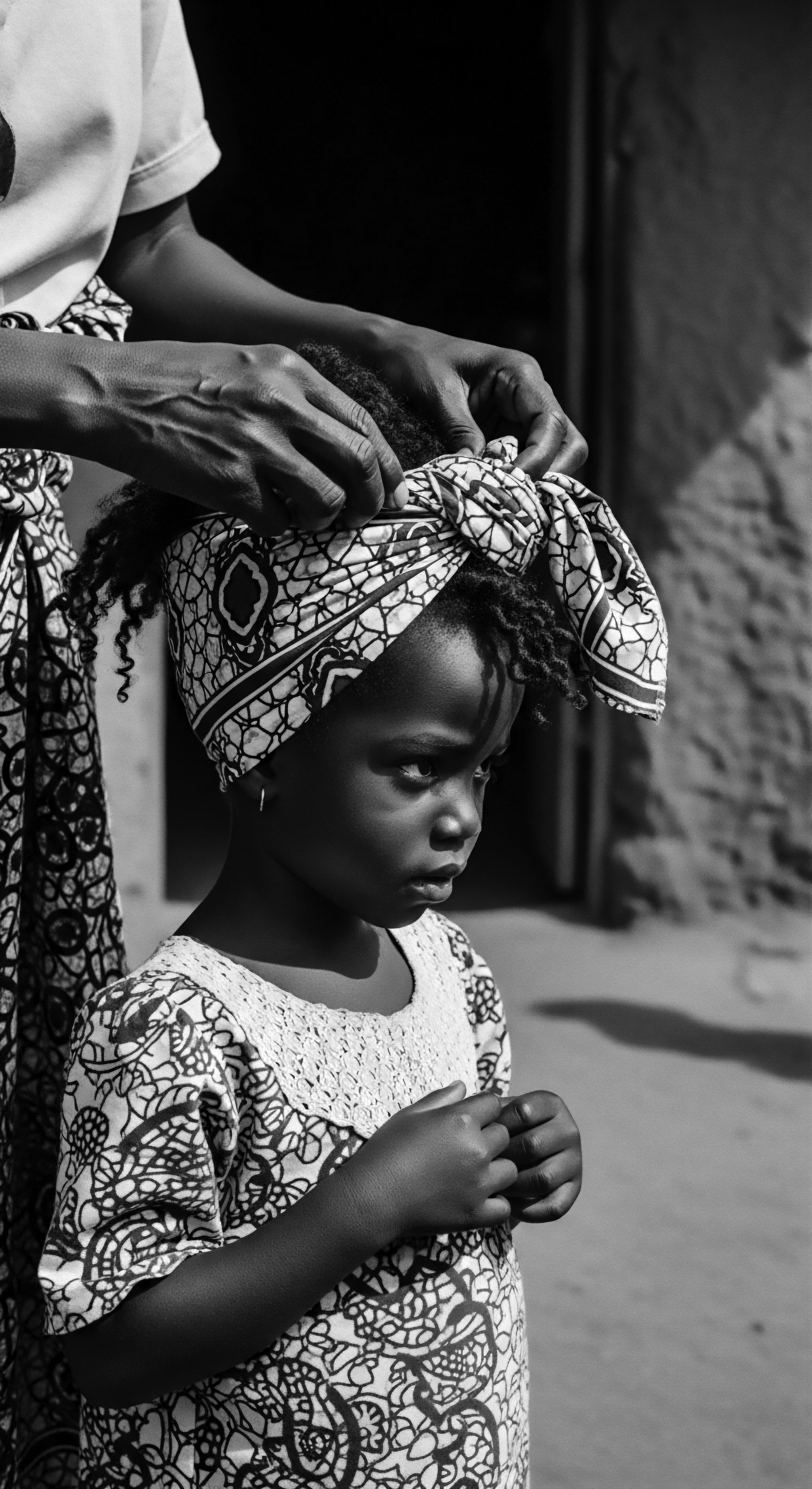
Biocultural Intersections ❉ The Science of Identity
The biological distinctiveness of textured hair, characterized by its elliptical follicle shape, varying curl patterns, and specific cuticle structure, is not merely a genetic lottery; it forms the elemental substrate upon which layers of cultural meaning have been built. This inherent biological variance has been, throughout history, interpreted and assigned social value, often detrimentally so. The scientific understanding of hair’s unique attributes, from its hydration needs to its susceptibility to breakage, validates many long-standing traditional care practices.
For instance, the natural coiling of textured hair makes it more prone to dryness due to the slower travel of sebum down the hair shaft. This scientific reality underpins the ancestral emphasis on oiling and moisturizing, demonstrating a practical wisdom that predates modern dermatological study.
Anthropological studies confirm that hair texture itself has been, and continues to be, a critical marker of race and group identity within the African diaspora, sometimes even superseding skin color or language in its symbolic weight. This physical attribute becomes a focal point for collective identity, a shared biological characteristic around which cultural practices, aesthetic preferences, and social narratives coalesce. The very act of caring for textured hair, from detangling to styling, becomes a practical application of biocultural knowledge, a testament to the intimate connection between biological form and cultural meaning.

Sociopolitical Contours ❉ Hair as a Locus of Power and Protest
The historical subjugation of Black and mixed-race peoples has consistently targeted hair as a site of control and oppression. During the transatlantic slave trade, the forced shaving of heads served as a symbolic and literal stripping away of identity, designed to erase ancestral connections and communal memory. This act initiated a long legacy of hair discrimination, where Eurocentric beauty standards were imposed as the norm, deeming textured hair as “unprofessional,” “unruly,” or “unacceptable.”
This historical context provides the framework for understanding contemporary hair discrimination. A 2023 study by Dove and LinkedIn revealed that Black Women’s Hair is 2.5 Times More Likely Than White and Hispanic Counterparts to Be Perceived as “unprofessional.” This pervasive bias extends into educational and professional spheres, with 66% of Black women reporting they change their hair for job interviews, and 41% of those opting for straightened styles. Furthermore, over 20% of Black women aged 25-34 have been sent home from work because of their hair. These statistics underscore the ongoing systemic challenges rooted in historical prejudices, demonstrating how deeply hair remains intertwined with issues of racial equity and social justice.
In response to this persistent discrimination, textured hair has consistently served as a powerful tool for cultural reclamation and political protest. The Civil Rights Movement saw the rise of the Afro as a potent symbol of Black power, self-acceptance, and defiance against oppressive beauty norms. Similarly, the natural hair movement, gaining momentum in the early 2000s, represents a contemporary wave of this ongoing resistance, encouraging individuals to embrace their natural textures as an affirmation of identity and a rejection of imposed standards. These movements illustrate the profound social and political substance hair carries, transforming it from a mere physical attribute into a banner of collective agency and self-determination.
- Hair as a Site of Oppression ❉ Historical practices, such as forced head shaving during enslavement, aimed to strip away cultural identity.
- Hair Discrimination ❉ Modern societal biases lead to textured hair being perceived as unprofessional, impacting employment and educational opportunities.
- Hair as Resistance ❉ The Afro and natural hair movement exemplify hair’s role in political and cultural reclamation.

Reclaiming the Crown ❉ Ancestral Knowledge in Contemporary Contexts
The contemporary understanding of Cultural Identity in textured hair involves a conscious and active re-engagement with ancestral knowledge, often validated and augmented by modern scientific inquiry. This is not a nostalgic retreat, but a forward-looking synthesis that recognizes the enduring value of traditional practices for long-term hair health and well-being. The efficacy of ancient hair oiling rituals, for instance, finds its scientific basis in the protective and moisturizing properties of natural lipids, which are particularly beneficial for the unique structure of coiled hair.
The ongoing research into ethnobotany, which studies the traditional knowledge of plants and their uses, continually uncovers the scientific underpinnings of ancestral hair care remedies. This cross-disciplinary approach allows for a deeper appreciation of the wisdom embedded in historical practices, providing a richer context for modern product development and care philosophies. It underscores the continuous lineage of understanding that stretches from ancient communal hearths to contemporary scientific laboratories.
The enduring wisdom of ancestral approaches to Cultural Identity, often centered on X, finds intriguing echoes and expansions in our contemporary scientific comprehension of Y, revealing a continuous thread of hair understanding.
The implications of this advanced understanding extend beyond individual hair care routines. It informs advocacy efforts for anti-discrimination legislation, such as the CROWN Act in the United States, which seeks to prohibit discrimination based on hair texture and protective hairstyles. It also shapes educational curricula, encouraging a more inclusive and historically accurate portrayal of textured hair, and influences the beauty industry towards more authentic and culturally respectful product development. The continuous process of identifying, preserving, and celebrating the historical and cultural roots of textured hair strengthens collective identity and paves the way for a future where all hair types are equally valued and celebrated.
This deep understanding also influences broader societal dialogues about identity, authenticity, and self-acceptance. By examining the complex layers of meaning associated with textured hair, we gain insights into the resilience of cultural memory and the power of personal expression. The long-term consequences of historical hair narratives are being actively addressed, leading to a more equitable and affirming environment for individuals of African descent to wear their hair as it naturally grows, unburdened by external judgments. This re-affirmation of cultural identity through hair contributes to holistic wellness, recognizing that outward appearance is inextricably linked to inner well-being and a sense of belonging.

Reflection on the Heritage of Cultural Identity
As we draw this meditation on Cultural Identity to a close, the resonant echoes of ancestral wisdom continue to reverberate, reminding us that the story of textured hair is an unending symphony of resilience and beauty. From the earliest communal rituals of adornment to the defiant acts of resistance during periods of immense hardship, and on to the vibrant expressions of selfhood in the modern world, the journey of Cultural Identity, as told through hair, is a profound testament to the enduring human spirit. Each coil, every curl, and every carefully crafted style carries within it the memory of generations, a living archive of joy, struggle, and unwavering determination.
Roothea’s ‘living library’ seeks to honor this sacred lineage, to provide a space where the deep heritage of textured hair is not merely acknowledged, but deeply felt and understood. It is a continuous unfolding, a recognition that the physical attributes of hair are inextricably bound to the spirit of a people, their history, and their aspirations. The tender care given to a strand, the shared laughter during a braiding session, the quiet strength found in a natural style — these are all expressions of a profound, inherited legacy.
This exploration invites us to witness hair not just as a crown, but as a map, a message, a declaration of who we are, where we come from, and the unbound future we are collectively shaping. The wisdom of the past, held within each textured strand, continues to guide our steps toward a more accepting and celebratory tomorrow.
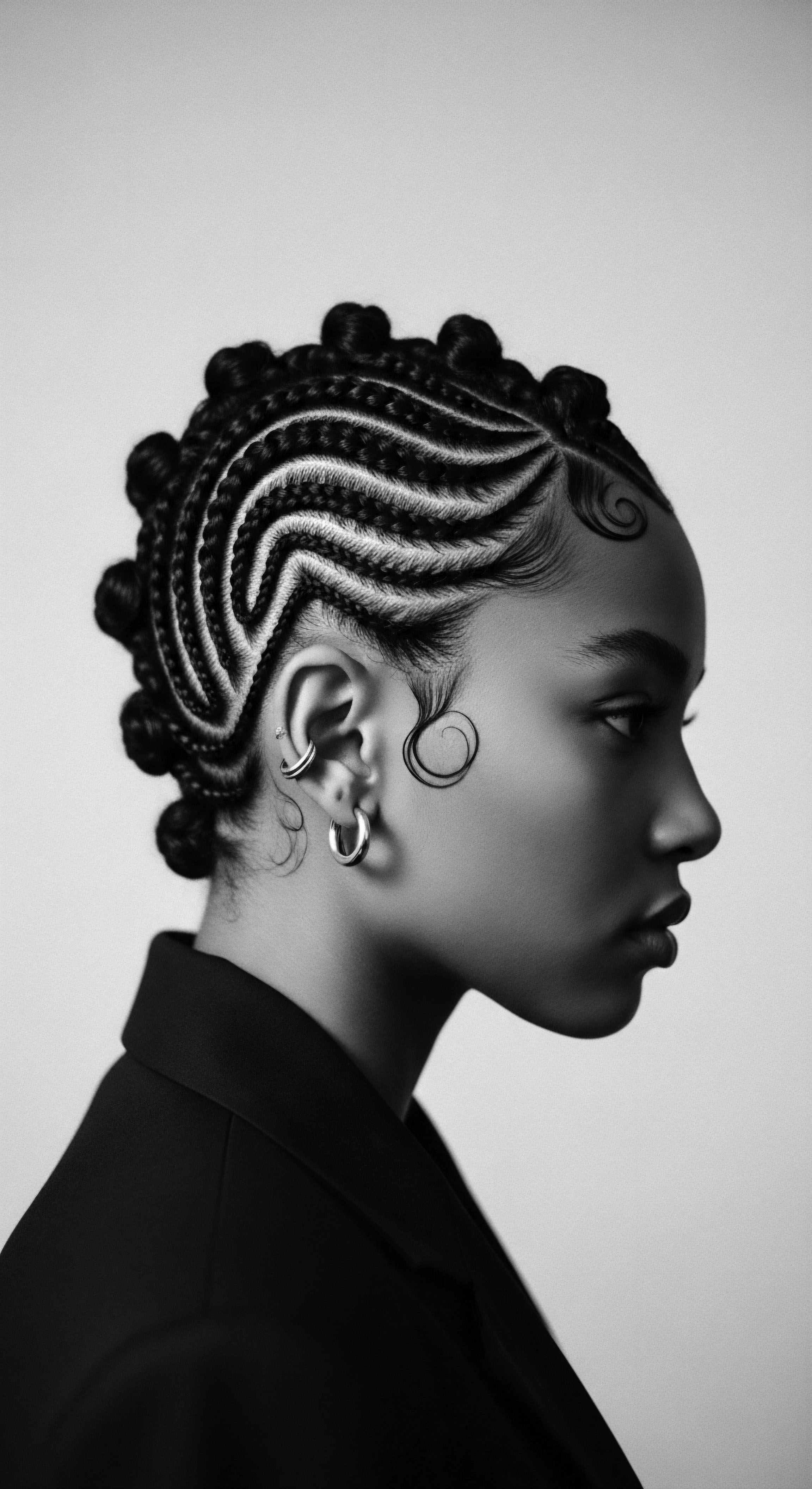
References
- 1. Beds SU. (2022). Black History Month 2022 ❉ The History Behind Cornrows.
- 2. Odele Beauty. (2024). A History Lesson On Hair Braiding.
- 3. BLAM UK CIC. (2022). The history of Black Hair.
- 4. Creative Support. (n.d.). The History of Black Hair.
- 5. Bogaard, C. (2022). African Slaves Used Braids to Communicate Escape Routes in Colombia. Ancient Origins.
- 6. Rosado, S. D. (2003). No Nubian Knots or Nappy Locks ❉ Discussing the Politics of Hair Among Women of African Decent in the Diaspora. A Report on Research.
- 7. Applied Worldwide Nigeria. (2024). Hidden Messages in Cornrows for the People of Color.
- 8. Lashley, M. (2017). The importance of hair in the identity of Black people. Érudit.
- 9. Wikipedia. (n.d.). Cornrows.
- 10. Oforiwa, A. (2021). 6 Things Everyone Should Know About Black Hair History. Odele Beauty.
- 11. Nyela, O. (2021). Braided Archives ❉ Black hair as a site of diasporic transindividuation. YorkSpace.
- 12. Thrifts & Tangles. (2021). The Evolution of Black Hair for Beauty & Resistance.
- 13. Scholar Commons. (2015). Redefining the Identity of Black Women ❉ “Natural” Hair and the Natural Hair Movement.
- 14. Oforiwa, A. (2023). The History and Culture of African Natural Hair ❉ From Ancient Times to Modern Trends. AMAKA Studio.
- 15. Odele Beauty. (2022). The History Behind Cornrows Is More Nuanced & Complex Than You Think.
- 16. Rosado, S. D. (2007). Nappy Hair in the Diaspora ❉ Exploring the Cultural Politics of Hair Among Women of African Desecent. UFDC Image Array 2.
- 17. Leidenanthropologyblog. (2017). ‘Hairstyle Politics’ ❉ Decolonizing Beauty Standards.
- 18. Rosado, S. D. (2003). No Nubian Knots or Nappy Locks ❉ Discussing the Politics of Hair Among Women of African Decent in the Diaspora. A Report on Research.
- 19. Wade, P. (2019). The Afro ❉ More Than a Hairstyle. Books & ideas – La Vie des idées.
- 20. University of Salford Students’ Union. (2024). The Remarkable History Behind Black Hairstyles.
- 21. Legal Defense Fund. (n.d.). Hair Discrimination FAQ.
- 22. World Afro Day. (2019). Hair Equality Report 2019.
- 23. Wilson, J. (2023). Hair discrimination rampant for Black women ❉ survey. Canadian HR Reporter.
- 24. Dove & LinkedIn. (2023). CROWN Act ❉ A jewel for combating racial discrimination in the workplace and classroom. Economic Policy Institute.
- 25. El Bouzidi, M. & Hssain, A. (2024). Ethnobotanical Survey of Medicinal Plants used in the Treatment and Care of Hair in Karia ba Mohamed (Northern Morocco). ResearchGate.
- 26. El Bouzidi, M. & Hssain, A. (2024). Ethnobotanical Survey of Medicinal Plants used in the Treatment and Care of Hair in Karia ba Mohamed (Northern Morocco).
- 27. Reddit. (2024). Authenticity of American slaves using hair styling as escape plans.
- 28. Thompson, C. (2009). Black women, beauty, and hair as a matter of being. Women’s Studies, 38(8), 831-856.
- 29. Orafidiya, L. O. & Okunlola, O. (2023). The Person Beneath the Hair ❉ Hair Discrimination, Health, and Well-Being. PMC.
- 30. Dove & LinkedIn. (2023). The CROWN Act ❉ A jewel for combating racial discrimination in the workplace and classroom. Economic Policy Institute.
